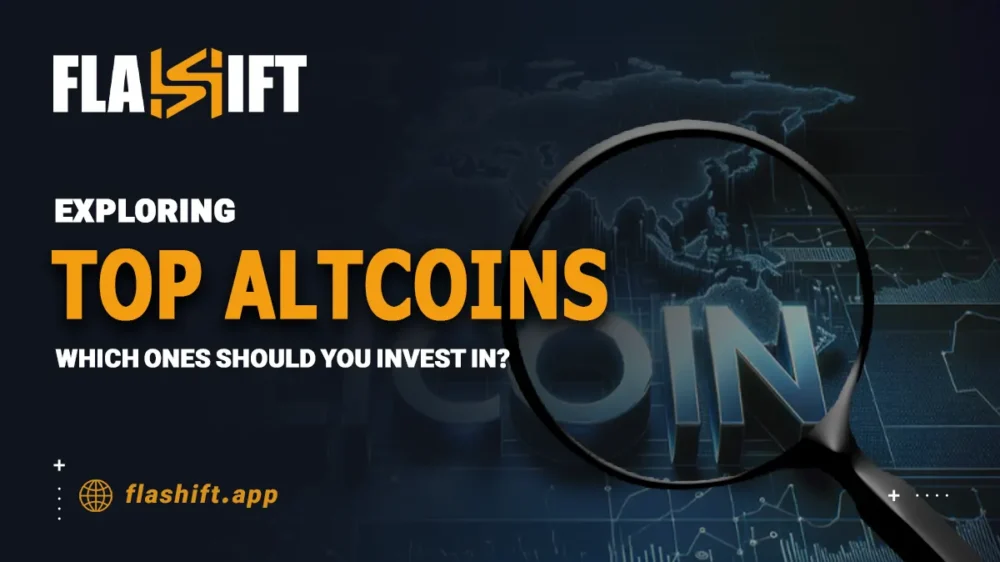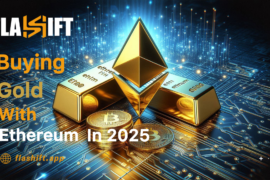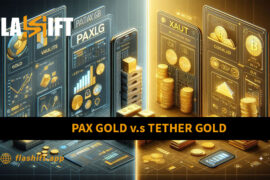Exploring the Top Altcoins | With the cryptocurrency market diversifying from Bitcoin and Ethereum, attention is now focused on a new breed of digital assets known as altcoins. Thousands are in circulation, touting different features and potential. To a single being, such a prospect would seem quite overwhelming when determining which ones are the real stand-out altcoins. An investor should be keenly interested in knowing the top altcoins in the market to gain the most return on investment and diversify his portfolio.
We consider key altcoins that have been most discussed recently and which are gaining momentum in the crypto space. We move from exploring their underlying technologies to some of their recent performance trends and, in this chapter, provide a comprehensive guide to help one make very well-informed investment decisions. Whether seasoned traders looking to diversify or new traders seeking to move beyond the main line of digital currencies, this analysis underlines altcoins that could become the future of digital finance.
To exchange cryptocurrency at the best rate, visit the Flashift website, create a registration-free transaction, and take advantage of a secure and speedy experience.
What are Altcoins?
With the world of cryptocurrencies growing, it’s as if we have used the term “altcoin” for each word related to digital assets. But what are altcoins per se? Where does this fit into the general idea of a cryptocurrency? Knowing altcoins could be paramount for anyone who wants to navigate the world of digital finance and investments. This article also details what altcoins are, how they differ from Bitcoin, and their relevance in the rising crypto market.
Definition of Altcoins
Well, the very name “altcoin” is derived from the words “alternative” and “coin,” hence referring to any cryptocurrency that is not Bitcoin. Bitcoin was developed by Satoshi Nakamoto, a pseudonymous person, in 2009. It was the very first independent digital currency. However, its alternative role brought into existence thousands of other digital currencies aimed at improving or offering another feature different from Bitcoin.
Read More: Navigating the Crypto Landscape: Identifying Promising Altcoins and Avoiding Shitcoins
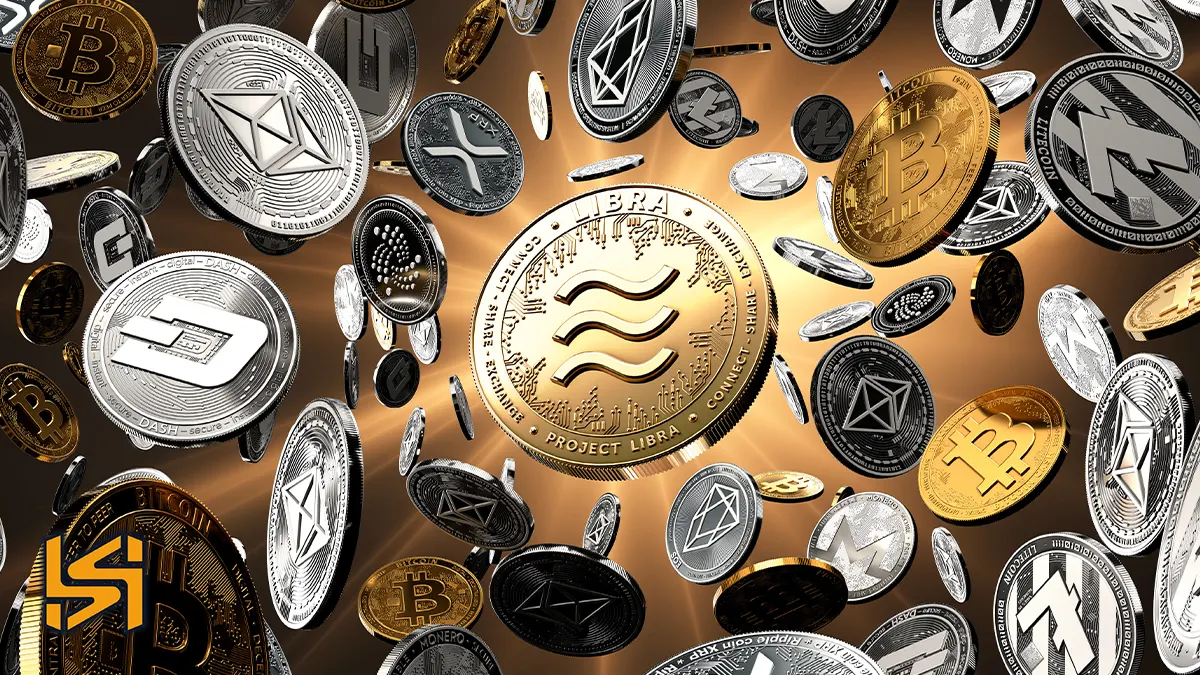
Types of Altcoins
Altcoins can broadly be divided into several types with distinct characteristics and purposes.
- Ethereum and Smart Contract Platforms: Ethereum is easily the most famous of the altcoins. Vitalik Buterin brought it into the limelight as far back as 2015. While Bitcoin is primarily used as digital cash, Ethereum hosts smart contracts, which can be defined as self-executing contracts with the terms of the agreement written directly into lines of code. This has paved the way for decentralized financial applications or projects. Other major smart contract platforms include Binance Smart Chain, otherwise known as BSC and Cardano.
- Stablecoins: They are usually pegged to a fiat currency or other asset to prevent the usual volatility in the said asset. Examples include Tether USDT, USD Coin USDC, and DAI. Today, they are primarily used in the crypto space as a medium of exchange and store of value.
- Privacy coins: Altcoins used to improve users’ anonymity and ensure more confidentiality in their transactions. Compared to Bitcoin, where every transaction is noted in the general public’s ledger, privacy coins like Monero and Zcash have been loaded with new cryptographic methods to blur transaction details and give better user privacy.
- Altcoins forked from Bitcoin: Altcoins created as a direct fork from the source code of Bitcoin rightfully fall under the term Bitcoin forks. They are further divided into “hard forks,” referring to a new cryptocurrency with big differences in the original Bitcoin protocol, like Bitcoin Cash, and “soft forks,” meaning backward-compatible updates like Bitcoin SegWit.
- Tokenized assets: There is a wide variety of assets that tokens can represent and, in turn, be further categorized under utility, security, and asset-backed tokens. Utility tokens would be spent on given platforms or ecosystems. One example of this is the Binance Coin. Security tokens would derive value by providing ownership regarding some traditional assets or financial instruments. Contrary to this, the asset-backed tokens would relate directly to some real, physical asset. This could be something like gold or real estate.
Altcoins are a class of cryptocurrency markets that are diversified and under development, parallel to Bitcoin in functionality and investment opportunity. It shows how much diversity in altcoins alone puts innovation and experimentation at the very front in the crypto industry, going from smart-contract platforms to privacy coins and further into tokenization. As in any other investment case, one has to pay great attention to education regarding specific characteristics and risks related to each of the altcoins. As the cryptocurrency scene changes, a greater need is created for investors to know altcoins to sail through the seas of a changing market.
Criteria for Evaluating Altcoins
A structured approach to evaluating potential and risk is necessary when considering altcoins. With thousands of cryptocurrencies available, careful consideration will be required concerning various factors to make informed investment decisions. The following are the key criteria to consider in the evaluation of altcoins:
- Technology and Innovation
- Underlying Technology: Look for the technology behind the altcoin. See if it comes with its blockchain or has some other consensus mechanism, like PoS or PoW, and analyze it for scalability, security, and efficiency.
- Innovation: Check if the altcoin offers innovative features or solves current problems. Does it introduce new smart contract functionality, enhance privacy, or improve transaction speed and cost?
- Use Case and Real-World Application
- Practical Use Case: Check if the altcoin has a real-world application. Does it solve a particular problem or address a hole in the market? If an altcoin has robust use cases and practical applications, it has more chances of gaining wider adoption.
- Adoption and Partnerships: Check the altcoin’s partnerships with established companies or institutions and its adoption rate in its target industry. Strong partnerships and large-scale adoption may indicate a bright future.
- Team and Development
- Team Experience: Check if the development team behind the altcoin has sufficient experience and a credible record of successes or failures. A team with prior blockchain-related or successful project experience generally holds credibility.
- Development Activity: Check the project’s development activity level. Active contributions on platforms like GitHub, regular updates, and a transparent development process suggest a well-maintained project.
- Market Performance and Liquidity
- Market Cap and Volume: Study the altcoin’s market capitalization and trading volume. Higher market cap and liquidity often indicate stability and investor interest. This can help avoid price manipulation and large spreads because there is less risk.
- Historical Performance: Consider the altcoin’s past price performance and volatility. Past performance may not guarantee future results, but it can give general guidelines for where the coin is heading.
- Community and Ecosystem
- Community Support: If an altcoin had one of the most prized assets it could have, that would be a large and active community. Please make sure it has active forums, is on major social media, and there is user engagement. The reason is simple: such a community can drive adoption and support.
- Ecosystem Development: Consider the ecosystem built around the altcoin, such as dApps, services, and projects on its platform. A rich and expanding ecosystem could bring additional value and utility to the altcoin.
- Regulatory and Compliance Factors
- Regulatory Status: Assess the altcoin’s regulatory circumstances. Make sure that it complies with the existing relevant regulations, and consider any legal risks that may threaten its viability.
- Transparency and Governance: Knowing a project’s transparency regarding its operations, governance model, and tokenomics is essential. Clear governance structures and transparent practices can reduce potential risks and increase trust.
- Tokenomics
- Supply and Distribution: Check the altcoin’s total supply and circulation. Knowing how tokens are allocated and the possibilities of inflation or deflation that may impact their value, one would use such information to arrive at a decision.
- Utility and Incentives: Learn how the altcoin works for people using the product within its ecosystem. Consider how tokens are used or if they give their holders an incentive, like staking rewards or access to some platform feature.
- Security and Risk Management
- Measures of Security: Scrutinize the security features of the altcoin concerning its codebase, network security, or any security incident on record. There is an excellent requirement for a strong security system that can save from vulnerabilities and attacks.
- Risk Factors: Identify the possible risks, technological flaws, market risks, or competition. A good risk assessment will help you understand the challenges and uncertainties that might be linked to such an altcoin.
- White Paper and Documentation
- White Paper: Review the altcoin’s white paper or technical documentation. It should articulate a vision, technology, use case, and roadmap for the project. A properly documented white paper details the project’s goals and feasibility.
- Project Roadmap and Milestones: Knowing the project roadmap and milestones helps understand past progress and future plans. A clear roadmap with achievable milestones would hint toward a well-planned strategy.
- Competitive Landscape
- Market Position: Compare the altcoin relative to its peers. Determine how it differentiates and has a competitive edge vis-a-vis technology, use case, or market positioning.
- Industry trends: Be informed of the industry’s trends and how they relate to or adjust their run due to changes in the market. Awareness of the general trends puts you at an excellent vantage point for assessing Altcoin’s prospects for further growth and relevance.
One has to adopt a holistic approach when it comes to evaluating altcoins. These would include technological, use case, market performance, and compliance with regulatory requirements. Through careful analysis of these factors, you can be better placed to make informed decisions about the altcoins with high potential to become successful. Given the dynamism and continuous evolution in the cryptocurrency market, there is an essential need for one to keep themselves abreast of the latest information and trends in practical evaluation and investment.
Read More: Top 10 Cryptocurrency Trading Strategies for Beginners in 2024
Top Altcoins to Watch in 2024
As the times take a steady turn, many altcoins slip into the spotlight in 2024 thanks to some original technologies and burgeoning ecosystems that bring the potential for significant impacts. Top among the altcoins that one should watch in 2024 are Ripple and Toncoin, together with some other promising contenders.
Ethereum still rules over the cryptocurrency industry. With capabilities in smart contracts and decentralized applications, Ethereum will also undergo significant overhauls as part of Ethereum 2.0, focusing on scalability and much-reduced energy consumption by shifting to Proof-of-Stake.
Why Watch: The robust DeFi project ecosystem, NFTs, and dApps, which are based on Ethereum, are in technological development processes, ensuring that they will not be sidelined from the crypto world.
Binance Coin is the native cryptocurrency of the Binance Exchange and comprises the core of its ecosystem. It is used for trading fee discounts, participation in new coin sales, and within the Binance Smart Chain for various DeFi and dApp projects.
Core Element to Watch: Continued expansion of Binance and multi-use cases of BNB within the Binance ecosystem sets its strong market position and future growth.
This one heavily emphasizes the development of a scalable and sustainable blockchain through a research-driven approach. Multi-layer architecture and, more recently, innovative contract capabilities continue pushing the digital currency’s utility in many applications.
Why Watch: Cardano, besides its fast-growing ecosystem, strongly emphasizes academic research into partnerships, and dApps categorizes it in an elite class of altcoins with long-term potential.
Polkadot made provisions for the interoperability of the different chains of blockchains. This would make the seamless transfer of data and assets across different blockchains possible. Innovative multi-chain architecture realizes the support of many diversified use cases and applications.
Why Watch: Given Polkadot’s ability to facilitate blockchain interoperability and its rapidly growing ecosystem of parachains, this project is a key player in the evolving landscape.
Because of its innovation, combined with Proof of Stake and Proof of History, Solana finds itself in a high-speed, inexpensive, no-compromise regime. It’s the up-and-coming platform to beat for DeFi projects and dApps.
Why Watch: Solana is scaling quickly with fast transaction throughput, so watching as adoption increases in DeFi and NFT is essential.
It is a high-performance blockchain platform with low latency and high throughput that empowers many diversified applications and networks with its customized blockchain infrastructure.
Why: This altcoin has a fresh consensus mechanism and a blooming ecosystem in the background, putting it at the forefront of both DeFi and innovative contract sectors.
Chainlink provides decentralized oracles for smart contracts, acting as the connecting bridge between on-chain applications and real-world data. Due to its secure data feeds, most projects in the DeFi space have used Chainlink.
Why Watch: The more data providers there are, the more critical Chainlink’s bridging of on-chain and off-chain data worlds becomes, which is an essential component of the cryptocurrency ecosystem.
Polygon is a Layer-2 scaling solution for Ethereum, formerly the Matic Network. It was created to speed up and make more affordable transactions on the Ethereum platform. It is a widely used solution combined with many dApps and DeFi projects.
Why You Should Watch: Polygon’s role in amplifying Ethereum’s scalability and expanding integration within the DeFi ecosystem have made it one of those altcoins to watch closely.
Created to conduct fast and low-cost international money transfers, Ripple’s concept has been implemented through its digital payment protocol, RippleNet, which numerous financial institutions use to quicken cross-border transactions.
Why to Watch: Continual lawsuits between Ripple and the SEC and the eventual settlement that may result will heavily affect the value of XRP. Couple this with a strong use case in the financial sector and the growing list of partnerships, and it is one of the altcoins to watch.
Toncoin is the native currency for the Telegram Open Network (TON), developed by the popular messaging application Telegram’s development team. The network aims to facilitate fast, scalable blockchain solutions and offer input for Telegram’s large user base.
Why watch: With the potential behind Toncoin to leverage Telegram’s massive user base and the focus on scalable blockchain solutions, it can become an up-and-coming project with substantial growth prospects.
It currently has original technology altcoins and various application scenarios for their use. The irrefutable leaders are Ethereum, Binance Coin, and Cardano, with their businesses standing out as the cream of the crop in ecosystems and activities involved. Toncoin and Ripple have unique chances and challenges in the new, emerging projects. Observing them closely and knowing their technological advances and market conditions give a lot of awareness towards an investment decision.
For exchanging Solana (SOL) to Ethereum (ETH) in one second, Flashift is the easiest way.
Risks and Rewards of Investing in Altcoins
Altcoins can offer both enormous opportunities and significant risks. As the cryptocurrency market continues to evolve, it becomes essential to be aware of both factors in order to make a better decision. The article discusses some important risks and rewards associated with investing in altcoins. Here is a detailed view of the benefits of investing in altcoins.
Benefits of Investing in Altcoins
- High Growth Potential
Innovation and Disruption: Most altcoins provide innovative technologies or new use cases that can disrupt traditional industries or create new markets. For example, there are substantial growth prospects in DeFi projects, NFT, and scalable blockchain solutions.
The chance of a high return in case promising altcoins realize early adoption of their projects. This is particularly true for altcoins with unique value propositions or technological advancements.
- Diversification:
By splitting an investment across various assets, rather than relying on a single cryptocurrency investment, there is less chance of losing the entire amount should one investment go wrong.
Unlike Bitcoin and Ethereum, altcoins provide an excellent opportunity for further diversification. A well-diversified portfolio will have a mix of well-established altcoins and new entrants that may help spread out risk and likely capture gains from the various sectors within the cryptocurrency market.
- Access to Emerging Technologies
State-of-the-Art Solutions: Most altcoins use high-end technologies like smart contracts, decentralized finance, and cross-chain interoperability. This exposes investors to new technologies that can become potential game changers within digital financing.
- High Potential Returns
Altcoin markets are characterized by volatility, which ultimately amounts to fast and intense price swings. While this is risky, at the same time, it also opens a window for huge short-term wins. For example, dramatic price surges may take off following successful launches or announcements with positive news.
- Financial innovation
DeFi and Smart Contracts: Altcoins is focused on decentralized finance, and innovative contract platforms present a whole new world of financial services and applications that can return much more than legacy financial systems. Several projects oriented at raising effectiveness and cutting expenses in finances are very profitable.
Read More: How to Safeguard Your Cryptocurrency Investments: A Complete Guide
Altcoin Investment Risks
- High Volatility
Altcoins are mostly very volatile, moving up and down tremendously in price. This volatility can give huge gains but often results in steep losses, thus making the management of portfolios pretty challenging.
- Regulatory Uncertainty
The regulatory landscape of cryptocurrencies, including altcoins, has yet to be adequately defined. Changes in regulations or legal challenges will dent the viability and value of altcoins. For instance, regulatory crackdowns or bad legal decisions can cause prices to fall or create problems in their operations.
- Security Concerns
There is no shortage of scams and hacks in the history of cryptocurrency. Many altcoins may fall victim to hacking or fraudulent activity or have poorly designed smart contracts. Investors must be cautious when studying information to avoid projects with poor security practices.
- No Liquidity
Most altcoins have thinner trading volumes and liquidity compared to Bitcoin and Ethereum. Therefore, buying or selling large amounts without affecting the price may become challenging, and slippage may become a risk.
- Project Viability
Technologies: Most altcoins are in development, and their technologies are yet to be proven. Such projects may not succeed; some will fail to make good on their promise or gain wide acceptance, causing potential losses for the investors.
- Market Sentiment
Hype is what has a significant effect on altcoin prices. Such happens in case this occurs. Speculative bubbles of that nature can eventually burst, inducing drastic declines in value. Investors should thus be able to tell between investments heightened by hype and those with solid fundamentals.
Altcoins allow for high potential returns and access to new technologies, but they also sustain substantial risks. High volatility, regulatory uncertainties, security concerns, and project viability are the significant factors that should be on the watch. To reduce risk, investors must do proper research into their investments, diversify portfolios, and constantly update themselves about the market conditions and development. In finding a balance between potential rewards and the understanding of the risks, investors can make wiser decisions and more effectively navigate the dynamic world of altcoin investments.
Diversifying Your Crypto Portfolio with Altcoins
Thus, having altcoins in a crypto portfolio is very strategic, increasing the potential for return while bringing down the risk of their investments. Diversification in many altcoins exposes one to many sectors of the cryptocurrency market, with diverse opportunities and challenges.
The next step into diversification means knowing precisely what you get into and how much risk you can live with. Diversification takes the form of investing in a well-spread portfolio over different assets to minimize the risks. Most of the time, it will lead to below-par performance compared to any asset in a diversified portfolio. Now, this is possible with cryptocurrencies, not only Bitcoin and Ethereum, but also investing in a suite of altcoins diversified by use case and technological innovation.
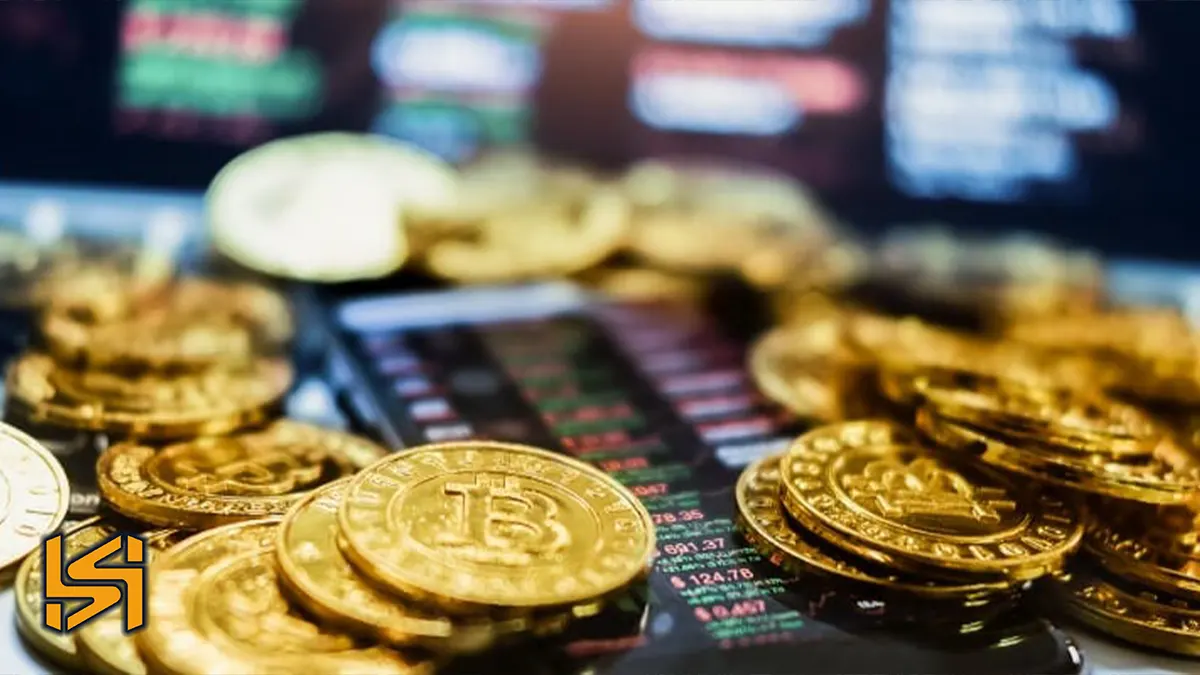
These could be altcoins with a number of different characteristics. For instance, smart contract platforms like Cardano or Polkadot have particularly unique solutions for decentralized applications and blockchain interoperability. Indeed, these platforms have formed the backbone that has driven the growth of decentralized finance and other applications on the blockchain. Secondly, stablecoins like USDT or USDC will lend relative stability and liquidity to your portfolio.
Following that, private-centric cryptocurrencies such as Monero or Zcash would come in. Simply put, these altcoins are focused on better security and even more anonymity regarding privacy in the digital age. This peculiarity will show up with some level of diversification, especially regarding privacy problems within the cryptocurrency space.
This would further incorporate some of the new emerging technologies and platforms. In most cases, one gets exposed to newer tasks, such as projects on Solana or Avalanche. These are new technologies with substantial growth potentials in transaction speed and scalable blockchain solutions. Most altcoins have promised lower transaction costs and faster processing times, an attractive proposition for the burgeoning crypto landscape.
Also worth considering are those that have substantial ecosystem development projects. Altcoins is sponsoring the broad development of decentralized applications to create diversified exposure to sub-markets of DeFi and NFTs created on Binance Smart Chain and Polygon. The value of the native tokens can rise as long as more usage in the ecosystem is validated.
However, one needs to be cautious while balancing the portfolio. The cryptocurrency market is so volatile that it is mostly speculative and fluctuates rapidly. Picking altcoins requires a good amount of research and due diligence. Assess the technology, team, use cases, and future market potential before investing money in altcoins to achieve long-term objectives.
This will help ensure that one’s cryptocurrency portfolio is well-diversified. Very sophisticated methods can narrow down options for leveraging growth across sectors, just like it would help hedge other risks that may have come from putting all of one’s money into one cryptocurrency. It helps balance a portfolio to the dynamic nature of the cryptocurrency market, enabling a positioning that empowers emerging opportunities while safely controlling exposure to possible downsides.
Read More: How to Choose the Best Cryptocurrency Exchange in 2024: A Comprehensive Review
Future Prospects of Popular Altcoins
Among the more popular altcoins, the future looks exciting as the cryptocurrency landscape evolves. Ethereum will significantly improve its scalability and efficiency with an upgrade to Ethereum 2.0, thus further entrenching its position in innovative contract use cases and decentralized applications. Binance Coin remains native to the Binance ecosystem. Due to the growth of the Binance Smart Chain and its wide variety of applications, BNB will remain the principal benefactor; however, how it finally goes through will depend on how it manages regulatory hurdles.
Cardano, however, has become a visible competitor thanks to its uncompromisingly research-driven approach and recent developments in smart contracts and network improvement. With Polkadot’s focus on interoperability across its multichain framework, there is potential in interlinked blockchain networks under development. Fast transactions at low fees set an appealing case for DeFi and NFTs on Solana, though stability in the network will be the key.
High-performance, customizable infrastructure targeting a broad scope of applications only brings it into its future based on ecosystem expansion. Chainlink’s contribution to dependable data feeds in DeFi and smart contracts is indispensable; further innovation is necessary. Polygon’s layer-2 solutions for Ethereum are targeted at solving scalability, so their success is pegged directly to the growth in Ethereum adoption.
The impending legal battles with the SEC are going to dent Ripple’s role in cross-border payments. Toncoin has a vast user base courtesy of Telegram and focuses on scalable solutions, but it calls for eventual integration into Telegram and further adoption.
Their future will depend on the coins’ ability to improve respective technological faults, follow up with market demands, and not become redundant within the fierce crypto space.
Conclusion
As the cryptocurrency market evolves, altcoins continue to diversify, offering new opportunities for investors. Coins like Polkadot and Solana are paving the way for enhanced scalability and faster transactions, while also driving the growth of decentralized finance (DeFi) ecosystems. Additionally, innovations like Layer 2 solutions and the integration of NFTs are transforming the functionality of these coins. As more projects explore blockchain interoperability, the altcoin market presents both exciting prospects and challenges, making it essential to stay updated on the latest trends and technological advancements.
FAQ
- How does altcoin differ from the actual Bitcoin?
Altcoins are any cryptocurrency except Bitcoin. They usually focus on improving Bitcoin’s features or alleviating some limitations, such as faster transaction times, lower fees, or additional features like adding smart contracts. Any altcoin could have unique qualities or use cases that set it apart from Bitcoin.
- Are altcoins suitable investments versus Bitcoin?
Compared to Bitcoin, altcoins have a potentially higher growth rate and can provide significant diversification. Their value largely depends on the underlying technology, use case, and market adoption. I would like to research an altcoin in detail before considering how it aligns with your investment strategy and risk tolerance.
- What to look for in an altcoin?
Some key factors to consider while evaluating altcoins are the technology powering the coin, the credibility of the development team, the coin’s use case, market demand, and total community support. Other sources of information on a project’s potential can be viewed vis-à-vis its whitepaper, roadmap, and regulatory compliance.
- How important is the development team behind an altcoin?
It will involve the development team since it’s the one that, through its experience, expertise, and event record, can drive altcoin into success and credibility. Most of the time, a strong, transparent, and experienced team indicates a higher chance of execution of the project together with innovation.
- Why should I invest in Ethereum and Binance Coin in 2024?
It holds top spots in smart-contract functionality and decentralized applications, and the ongoing upgrades will eventually make it more scalable and efficient. Since its core purpose lies within the Binance ecosystem, the growth of the Binance Smart Chain will be felt by Binance Coin through many use cases, from trading fee discounts to token sales.
- What is Unique about Toncoin and Ripple in 2024?
Toncoin has potential due to its association with Telegram’s vast user base and scalable blockchain solutions. Ripple, despite ongoing legal battles, is a force in the realm of cross-border payment solutions. Its prospects are strongly linked to resolving legal issues and further expansion within the financial sector.
- What are the leading risks with altcoin investing?
Primary risks are those associated with high volatility, regulatory uncertainties, security concerns, and issues related to project viability. The price of altcoins can swing wildly, their legal status can be challenged, or they can be hacked and become victims of fraud. Also, most altcoins are still unproven and will not achieve the goals and predictions set for them.
- What are some potential rewards for investing in altcoins?
Altcoins can offer investors high growth potential, diversified exposure, and receptiveness to new technologies. Successful altcoins with highly resourceful solutions or strong market demand can result in high returns. A diversified investment in different altcoins can also reduce overall portfolio risk by investing across various assets.
- How to effectively diversify your crypto portfolio with Altcoins?
Diversify effectively by including some established altcoins with extreme use cases, as well as some emerging projects with high growth potential. Balance your investments within different sectors like DeFi, privacy coins, layer-2 solutions, etc., but make sure you understand the risks and benefits of each altcoin.
- Why is diversification important in a crypto portfolio?
Diversification lowers risk by investing in multiple assets. Such a strategy can help weather less poor performance in any asset in the volatile cryptocurrency market and increase the likelihood of capturing gains from various sectors and technologies.
- What are some deciding factors for Ethereum and Cardano’s success in the future?
For the future success of Ethereum, actualization will be required in the Ethereum 2.0 upgrades: improvements in scalability and reduced energy consumption. In the case of Cardano, this strong research orientation, together with the successful deployment of smart contracts and real-world partnerships, will carry it through.
- How about Polkadot and Solana? How would they perform over the next coming years?
Polkadot’s future performance will depend on integrating various para chains and facilitating cross-chain interactions. Solana’s prospects are strongly linked to maintaining network stability and scalability while supporting growing DeFi and NFT applications.


